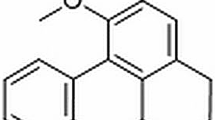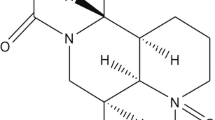Abstract
Bovine mastitis is defined as the inflammation of mammary gland and is the most multiple diseases in dairy cattle. There is still no effective treatment now. Leonurine, extracted from Leonurus cardiaca, has been proved to have anti-inflammatory effect. In the present study, we utilized a mouse mastitis model to study the effect of leonurine on LPS-induced mastitis. Leonurine was administered three times during the 24 h after inducing infection in the mammary gland. The results showed that leonurine significantly alleviated LPS-induced histopathological changes, downregulated the levels of pro-inflammatory cytokines tumor necrosis factor-α (TNF-α), interleukin-6 (IL-6), upregulated the level of anti-inflammatory cytokine interleukin-10 (IL-10), and inhibited the expression of inducible nitric oxide synthase (iNOS) and cyclooxygenase-2 (COX-2). Further study revealed that leonurine inhibited the expression of Toll-like receptor 4 (TLR4) and the activation of nuclear factor-kappaB (NF-κB) and the phosphorylation of p38, extracellular signal-regulated kinase (ERK), and Jun N-terminal kinase (JNK). Therefore, the results demonstrated that leonurine could downregulate the expression of TNF-α, IL-6, iNOS, and COX-2 and upregulate the expression of IL-10 mainly by inhibiting the expression of TLR4 and the activation of NF-κB and the phosphorylation of p38, ERK, and JNK. Leonurine may be a potential agent for mastitis therapy.

ᅟ







Similar content being viewed by others
References
Viguier, C., S. Arora, N. Gilmartin, K. Welbeck, and R. O’Kennedy. 2009. Mastitis detection: current trends and future perspectives. Trends in Biotechnology 27(8): 486–493.
Gilbert, F.B., P. Cunha, K. Jensen, E.J. Glass, G. Foucras, C. Robert-Granie, R. Rupp, and P. Rainard. 2013. Differential response of bovine mammary epithelial cells to Staphylococcus aureus or Escherichia coli agonists of the innate immune system. Veterinary Research 44: 40.
Coliform mastitis—a review. Journal of dairy science 1979, 62 (1):1–22.
Zhao, X., and P. Lacasse. 2008. Mammary tissue damage during bovine mastitis: causes and control. Journal of Animal Science 86(13 Suppl): 57–65.
Schalm, O.W., E.J. Carroll, and N.C. Jain. 1971. Bovine mastitis. In Bovine mastitis A symposium. Philadelphia: Lea & Febiger.
Oliver, S., and L. Calvinho. 1995. Influence of inflammation on mammary gland metabolism and milk composition. Journal of Animal Science 73(suppl 2): 18–33.
Aderem, A., and R.J. Ulevitch. 2000. Toll-like receptors in the induction of the innate immune response. Nature 406(6797): 782–787.
Hirschfeld, M., Y. Ma, J.H. Weis, S.N. Vogel, and J.J. Weis. 2000. Cutting edge: repurification of lipopolysaccharide eliminates signaling through both human and murine toll-like receptor 2. Journal of Immunology 165(2): 618–622.
Espinosa-Oliva AM, de Pablos RM, Herrera AJ. 2013. Intracranial injection of LPS in rat as animal model of neuroinflammation. In: Microglia. edn.: Springer : 295–305.
González-Terán, B., J.R. Cortés, E. Manieri, N. Matesanz, Á. Verdugo, M.E. Rodríguez, Á. González-Rodríguez, Á. Valverde, P. Martín, and R.J. Davis. 2013. Eukaryotic elongation factor 2 controls TNF-α translation in LPS-induced hepatitis. The Journal of Clinical Investigation 123(1): 164–178.
Han, J.G., Y.S. Kim, B.S. Kim, and Y.K. Yim. 2014. The effect of Alismatis Rhizoma herbal-acupuncture at KI10 on LPS-induced nephritis in rats. The Acupuncture 31(1): 51–60.
Takeuchi, O., K. Hoshino, T. Kawai, H. Sanjo, H. Takada, T. Ogawa, K. Takeda, and S. Akira. 1999. Differential roles of TLR2 and TLR4 in recognition of gram-negative and gram-positive bacterial cell wall components. Immunity 11(4): 443–451.
Chandler, R.L. 1970. Experimental bacterial mastitis in the mouse. Journal of Medical Microbiology 3(2): 273–282.
Chandler, R.L. 1969. Preliminary report on the production of experimental mastitis in the mouse. The Veterinary Record 84(26): 671–672.
Notebaert, S., and E. Meyer. 2006. Mouse models to study the pathogenesis and control of bovine mastitis. A review. Vet Quart 28(1): 2–13.
Li, F., D. Liang, Z. Yang, T. Wang, W. Wang, X. Song, M. Guo, E. Zhou, D. Li, Y. Cao, et al. 2013. Astragalin suppresses inflammatory responses via down-regulation of NF-kappaB signaling pathway in lipopolysaccharide-induced mastitis in a murine model. International Immunopharmacology 17(2): 478–482.
Guo, M.Y., N.S. Zhang, D.P. Li, D.J. Liang, Z.C. Liu, F.Y. Li, Y.H. Fu, Y.G. Cao, X.M. Deng, and Z.T. Yang. 2013. Baicalin plays an anti-inflammatory role through reducing nuclear factor-kappa B and p38 phosphorylation in S. aureus-induced mastitis. International Immunopharmacology 16(2): 125–130.
Wang T, Guo M, Song X, Zhang Z, Jiang H, Wang W, Fu Y, Cao Y, Zhu L, Zhang N. 2014. Stevioside plays an anti-inflammatory role by regulating the nf-kappaB and MAPK pathways in S. aureus-infected mouse mammary glands. Inflammation.
Liu, X.H., L.L. Pan, H.Y. Deng, Q.H. Xiong, D. Wu, G.Y. Huang, Q.H. Gong, and Y.Z. Zhu. 2013. Leonurine (SCM-198) attenuates myocardial fibrotic response via inhibition of NADPH oxidase 4. Free Radical Biology & Medicine 54: 93–104.
Liu, X.H., H. Xin, A.J. Hou, and Y.Z. Zhu. 2009. Protective effects of leonurine in neonatal rat hypoxic cardiomyocytes and rat infarcted heart. Clin Exp Pharmacol P 36(7): 696–703.
Liu, X.H., L.L. Pan, Q.H. Gong, and Y.Z. Zhu. 2010. Antiapoptotic effect of novel compound from Herba leonuri-leonurine (SCM-198): a mechanism through inhibition of mitochondria dysfunction in H9c2 cells. Curr Pharm Biotechno 11(8): 895–905.
Liu, X.H., L.L. Pan, X.L. Wang, Q.H. Gong, and Y.Z. Zhu. 2012. Leonurine protects against tumor necrosis factor-alpha-mediated inflammation in human umbilical vein endothelial cells. Atherosclerosis 222(1): 34–42.
Song X, Zhang W, Wang T, Jiang H, Zhang Z, Fu Y, Yang Z, Cao Y, Zhang N. 2014. Geniposide plays an anti-inflammatory role via regulating TLR4 and downstream signaling pathways in lipopolysaccharide-induced mastitis in mice. Inflammation.
Li, Q., and I.M. Verma. 2002. NF-kappaB regulation in the immune system. Nature Reviews Immunology 2(10): 725–734.
Strandberg, Y., C. Gray, T. Vuocolo, L. Donaldson, M. Broadway, and R. Tellam. 2005. Lipopolysaccharide and lipoteichoic acid induce different innate immune responses in bovine mammary epithelial cells. Cytokine 31(1): 72–86.
Brouillette, E., and F. Malouin. 2005. The pathogenesis and control of Staphylococcus aureus-induced mastitis: study models in the mouse. Microbes and Infection 7(3): 560–568.
Bannerman, D.D., M.J. Paape, J.W. Lee, X. Zhao, J.C. Hope, and P. Rainard. 2004. Escherichia coli and Staphylococcus aureus elicit differential innate immune responses following intramammary infection. Clinical and Diagnostic Laboratory Immunology 11(3): 463–472.
Wojtyniak, K., M. Szymanski, and I. Matlawska. 2013. Leonurus cardiaca L. (motherwort): a review of its phytochemistry and pharmacology. Phytotherapy research : PTR 27(8): 1115–1120.
Xu, D., M. Chen, X. Ren, X. Ren, and Y. Wu. 2014. Leonurine ameliorates LPS-induced acute kidney injury via suppressing ROS-mediated NF-kappaB signaling pathway. Fitoterapia 97C: 148–155.
Oviedo-Boyso, J., J.J. Valdez-Alarcon, M. Cajero-Juarez, A. Ochoa-Zarzosa, J.E. Lopez-Meza, A. Bravo-Patino, and V.M. Baizabal-Aguirre. 2007. Innate immune response of bovine mammary gland to pathogenic bacteria responsible for mastitis. The Journal of Infection 54(4): 399–409.
Persson Waller, K., I.G. Colditz, S. Lun, and K. Ostensson. 2003. Cytokines in mammary lymph and milk during endotoxin-induced bovine mastitis. Research in Veterinary Science 74(1): 31–36.
Platzer, C. 2003. Interleukin-10: an anti-inflammatory and immunosuppressive cytokine in the normal and pathological immune response. Current Medicinal Chemistry-Anti-Inflammatory & Anti-Allergy Agents 2(4): 309–323.
Redpath, S., P. Ghazal, and N.R. Gascoigne. 2001. Hijacking and exploitation of IL-10 by intracellular pathogens. Trends in Microbiology 9(2): 86–92.
Liang, D., F. Li, Y. Fu, Y. Cao, X. Song, T. Wang, W. Wang, M. Guo, E. Zhou, D. Li, et al. 2014. Thymol inhibits LPS-stimulated inflammatory response via down-regulation of NF-kappaB and MAPK signaling pathways in mouse mammary epithelial cells. Inflammation 37(1): 214–222.
Muller-Decker, K., and G. Furstenberger. 2007. The cyclooxygenase-2-mediated prostaglandin signaling is causally related to epithelial carcinogenesis. Molecular Carcinogenesis 46(8): 705–710.
Sakthivel, K.M., and C. Guruvayoorappan. 2013. Amentoflavone inhibits iNOS, COX-2 expression and modulates cytokine profile, NF-kappaB signal transduction pathways in rats with ulcerative colitis. International Immunopharmacology 17(3): 907–916.
Xiong H, Cheng Y, Zhang X, Zhang X. 2014. Effects of taraxasterol on iNOS and COX-2 expression in LPS-induced RAW 264.7 macrophages. Journal of ethnopharmacology.
Zhu, Y., M. Zhu, and P. Lance. 2012. iNOS signaling interacts with COX-2 pathway in colonic fibroblasts. Experimental Cell Research 318(16): 2116–2127.
Kundu, J.K., and Y.-J. Surh. 2004. Molecular basis of chemoprevention by resveratrol: NF-κB and AP-1 as potential targets. Mutation Research/Fundamental and Molecular Mechanisms of Mutagenesis 555(1): 65–80.
Thalhamer, T., M.A. McGrath, and M.M. Harnett. 2008. MAPKs and their relevance to arthritis and inflammation. Rheumatology 47(4): 409–414.
Lu, Y.C., W.C. Yeh, and P. Ohashi. 2008. LPS/TLR4 signal transduction pathway. Cytokine 42(2): 145–151.
Acknowledgments
This work was supported by a grant from the National Natural Science Foundation of China (Nos. 31272622, 31201925), the Research Fund for the Doctoral Program of Higher Education of China (Nos. 20110061130010, 20120061120098), and Jilin Province Science Foundation for Youths (No. 20130522087JH).
Conflict of Interest
The authors declare that there is no conflict of interests regarding the publication of this paper.
Author information
Authors and Affiliations
Corresponding authors
Additional information
Xiaojing Song and Tiancheng Wang contributed equally to this work and are to be considered the first authors.
Rights and permissions
About this article
Cite this article
Song, X., Wang, T., Zhang, Z. et al. Leonurine Exerts Anti-Inflammatory Effect by Regulating Inflammatory Signaling Pathways and Cytokines in LPS-Induced Mouse Mastitis. Inflammation 38, 79–88 (2015). https://doi.org/10.1007/s10753-014-0009-9
Published:
Issue Date:
DOI: https://doi.org/10.1007/s10753-014-0009-9




